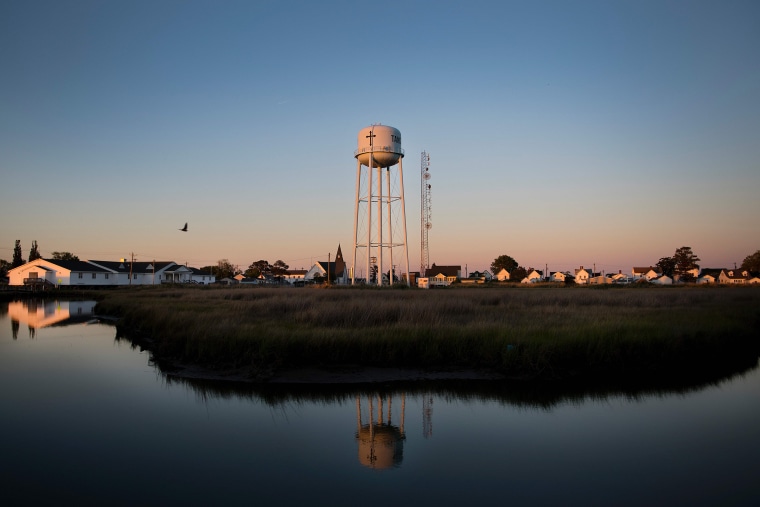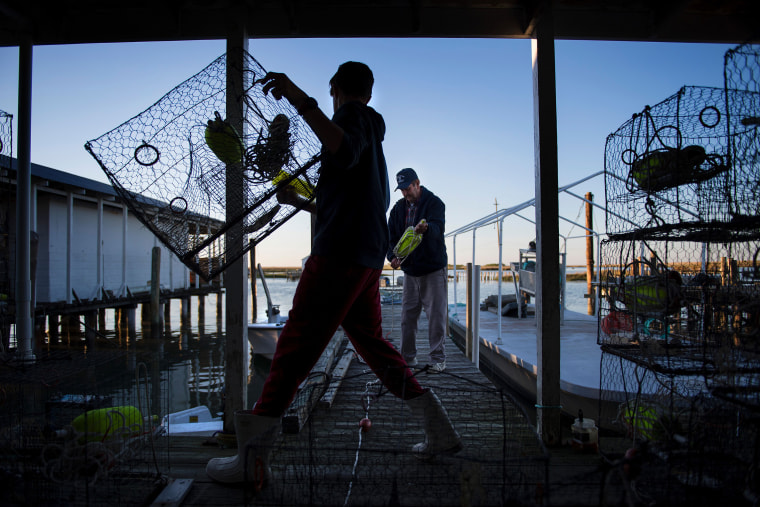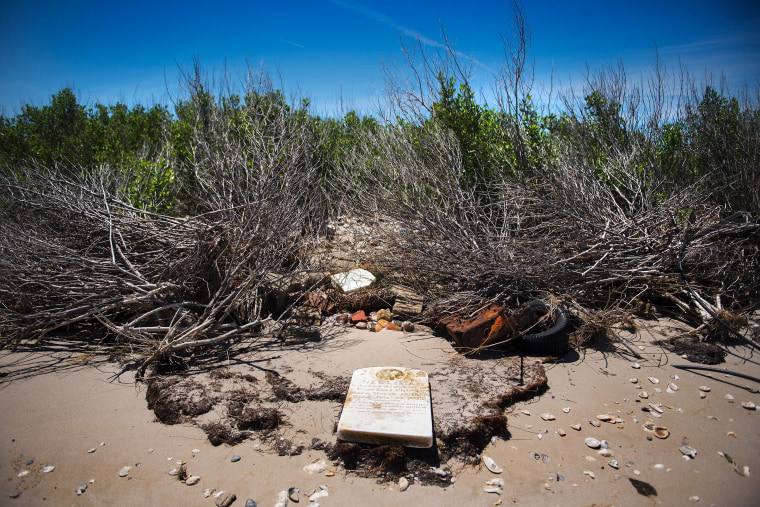A new study found that Tangier Island is losing ground faster than previously thought, highlighting how climate change threatens U.S. coastal communities.

The sun sets in Tangier, Va., on May 15, 2017, where climate change and rising sea levels threaten the inhabitants of the slowly sinking island.
Jim Watson / AFP via Getty Images file
Nov. 10, 2021, 1:32 PM MST
By Evan Bush
Tangier Island, home to a Virginia fishing town and about 400 people, could be saturated by rising seas and convert to uninhabitable wetlands by 2051, according to an analysis released Monday.
The tiny island, which drew national attention for its residents’ support of former President Donald Trump and skepticism of climate change, is one of many Chesapeake Bay islands sinking because of local sea level rise and subsidence. People have lived on the island since the 18th century, but the residents could soon face displacement.
The new study, published Monday in the peer-reviewed journal Frontiers in Climate, estimates that it would cost about $150 million to relocate the town of Tangier’s residents and as much as $350 million to bulk up the island and protect its shoreline.
The quick timeline and steep costs for relocating a single small town illustrate the challenges the United States faces as sea levels rise and flooding increasingly threatens coastal communities. Millions of Americans could be forced to move from flood-prone areas by the year 2100, according to the 2018 U.S. national climate assessment. No federal agency has the authority to lead national assistance on climate migration efforts, a 2020 Government Accountability Office report said.
“What people are going to start realizing quickly, dealing with climate change is going to be an extremely expensive undertaking,” said Dave Schulte, a scientist for the U.S. Army Corps of Engineers and one of the paper’s two authors. “A lot of towns and cities are going to have similar estimates, and I have no idea where we’re going to get that money.”
‘Not sold’
Tangier is the kind of place where churches are at the core of the community, kids cruise the streets on bicycles, parents don’t worry about them and the sunset reminds you why you love home, said James “Ooker” Eskridge, a waterman who serves as the “close-knit” community’s mayor.
Tangier is mostly white and working class, and its economy since the 1880s has centered on fishing, crabbing and oystering, said Jonna Yarrington, an anthropologist at the University of Virginia who lived on the island for about a year, wrote a dissertation about Tangier and is working on a book about it. In recent decades, job opportunities have declined and the population has dwindled, Yarrington said.
Today, the island is a haven for blue crab, Conservative political views and journalists, drawn in recent years to the tale of a “Trump-loving” island of “climate skeptics” whose home faces an existential threat.
 Benjamin Eskridge, left, carries a crab trap while helping his grandfather Allen Crocket prepare for the next day of crabbing in Tangier, Va., on May 15, 2017. Jim Watson / AFP via Getty Images file
Benjamin Eskridge, left, carries a crab trap while helping his grandfather Allen Crocket prepare for the next day of crabbing in Tangier, Va., on May 15, 2017. Jim Watson / AFP via Getty Images file
It’s an image embraced by Eskridge, who welcomes reporters in hopes media attention might help save the island.
Eskridge said he’s personally not convinced humans are the cause of climate change, and he’s unsure what can — or should — be done about it.
“I think we need to adjust to it, but as far as stopping it, I’m not sold,” he said. In his view, it’s erosion that is bedeviling the island. (Sea level rise can exacerbate coastal erosion. The study found that sea level rise is driving the sinking of Tangier and that stopping coastal erosion alone wouldn’t save the town.)
While many Tangier residents might not agree that climate change is the culprit, they’ve watched their island shrink for decades.
Exodus by 2053
Last spring, when Zehao Wu, now 18, brought his computer into the family living room to show off the results of the project he’d been fiddling with for weeks, his dad “jumped out of his chair.”
For years, Schulte, Wu’s father, had been talking about Tangier Island around the dinner table, often venting frustration at how little action had been taken to help communities like it.
Schulte, a marine scientist based in Norfolk, Virginia, had published a paper in 2015 in Scientific Reports predicting Tangier might soon need to be abandoned. The 2015 study said the land mass was on pace to be lost in the next 50 years.
The paper stirred media interest but no commitment from policymakers to save the town. And Schulte felt that people misunderstood the cause of Tangier’s problems — that accelerating sea level rise is to blame.
In 2017, after CNN aired a segment that noted Tangier Island’s support of Trump, the president himself phoned Eskridge to tell him not to worry about sea level rise and that the town would last for hundreds more years.
Wu’s computer screen last spring said otherwise.
Data analysis of satellite mapping showed that Tangier Island had lost nearly 62 percent of its upland area since 1967.
“I was really astounded at the change. It was much larger than I thought I knew at that time,” Schulte said.
Over the next months, on weekends and after high school classes, Wu pulled up a bean bag chair beside his father’s desk, and the pair worked side-by-side to finish their paper explaining the pace at which data suggests seawater will saturate the island.
“My science teacher is really pumped,” said Wu, who worries that poor and disadvantaged communities will be left behind as the nation adapts to climate change.
The study paints a disquieting picture for Tangier Island. More than two-thirds of the island’s land mass is gone. Most individual properties now contain wetland areas. Two of the islands’ ridges are expected to become wetland in the 2030s, with the third expected to succumb by 2051, the paper states.
The rate of relative sea level rise has accelerated. A model of Tangier’s population decline, which predicts a total exodus by 2053, shows that it trends similarly to the decline in habitable land.
“You can’t live in a swamp,” Wu said.

Storm surge
In the days before the study was published, a nor’easter and high tides battered Tangier Island, Eskridge said. It flooded at least 10 of the island’s 210 homes. Platforms for crab pots collapsed and crab shanties were damaged.
“Even guys in their 80s hadn’t seen the water so high before,” Eskridge said. “This time, homes got water that never had to worry about it before.”
Eskridge and Schulte might not agree on what is causing Tangier’s demise, but they share a similar hope for its future. The island needs help soon, they say.
The local fishing community is mostly self reliant, “but this erosion issue is too large to deal with,” Eskridge said. “We do need help from the government to do it.”
Schulte estimates that it would take $250 million to 350 million to protect the island’s shoreline with stone and oyster reefs, raise the landscape with dredged sand and then retrofit much of the town’s infrastructure. (Eskridge thinks the island could be built up and protected for a fraction of that cost.)
“If America decides to save things in the order of what’s economically productive, all these small towns like Tangier are going to get abandoned,” Schulte said. “I think it’s worth the effort to save the town.”
Nov. 10, 2021, 1:32 PM MST
By Evan Bush
Tangier Island, home to a Virginia fishing town and about 400 people, could be saturated by rising seas and convert to uninhabitable wetlands by 2051, according to an analysis released Monday.
The tiny island, which drew national attention for its residents’ support of former President Donald Trump and skepticism of climate change, is one of many Chesapeake Bay islands sinking because of local sea level rise and subsidence. People have lived on the island since the 18th century, but the residents could soon face displacement.
The new study, published Monday in the peer-reviewed journal Frontiers in Climate, estimates that it would cost about $150 million to relocate the town of Tangier’s residents and as much as $350 million to bulk up the island and protect its shoreline.
The quick timeline and steep costs for relocating a single small town illustrate the challenges the United States faces as sea levels rise and flooding increasingly threatens coastal communities. Millions of Americans could be forced to move from flood-prone areas by the year 2100, according to the 2018 U.S. national climate assessment. No federal agency has the authority to lead national assistance on climate migration efforts, a 2020 Government Accountability Office report said.
“What people are going to start realizing quickly, dealing with climate change is going to be an extremely expensive undertaking,” said Dave Schulte, a scientist for the U.S. Army Corps of Engineers and one of the paper’s two authors. “A lot of towns and cities are going to have similar estimates, and I have no idea where we’re going to get that money.”
‘Not sold’
Tangier is the kind of place where churches are at the core of the community, kids cruise the streets on bicycles, parents don’t worry about them and the sunset reminds you why you love home, said James “Ooker” Eskridge, a waterman who serves as the “close-knit” community’s mayor.
Tangier is mostly white and working class, and its economy since the 1880s has centered on fishing, crabbing and oystering, said Jonna Yarrington, an anthropologist at the University of Virginia who lived on the island for about a year, wrote a dissertation about Tangier and is working on a book about it. In recent decades, job opportunities have declined and the population has dwindled, Yarrington said.
Today, the island is a haven for blue crab, Conservative political views and journalists, drawn in recent years to the tale of a “Trump-loving” island of “climate skeptics” whose home faces an existential threat.
 Benjamin Eskridge, left, carries a crab trap while helping his grandfather Allen Crocket prepare for the next day of crabbing in Tangier, Va., on May 15, 2017. Jim Watson / AFP via Getty Images file
Benjamin Eskridge, left, carries a crab trap while helping his grandfather Allen Crocket prepare for the next day of crabbing in Tangier, Va., on May 15, 2017. Jim Watson / AFP via Getty Images fileIt’s an image embraced by Eskridge, who welcomes reporters in hopes media attention might help save the island.
Eskridge said he’s personally not convinced humans are the cause of climate change, and he’s unsure what can — or should — be done about it.
“I think we need to adjust to it, but as far as stopping it, I’m not sold,” he said. In his view, it’s erosion that is bedeviling the island. (Sea level rise can exacerbate coastal erosion. The study found that sea level rise is driving the sinking of Tangier and that stopping coastal erosion alone wouldn’t save the town.)
While many Tangier residents might not agree that climate change is the culprit, they’ve watched their island shrink for decades.
Exodus by 2053
Last spring, when Zehao Wu, now 18, brought his computer into the family living room to show off the results of the project he’d been fiddling with for weeks, his dad “jumped out of his chair.”
For years, Schulte, Wu’s father, had been talking about Tangier Island around the dinner table, often venting frustration at how little action had been taken to help communities like it.
Schulte, a marine scientist based in Norfolk, Virginia, had published a paper in 2015 in Scientific Reports predicting Tangier might soon need to be abandoned. The 2015 study said the land mass was on pace to be lost in the next 50 years.
The paper stirred media interest but no commitment from policymakers to save the town. And Schulte felt that people misunderstood the cause of Tangier’s problems — that accelerating sea level rise is to blame.
In 2017, after CNN aired a segment that noted Tangier Island’s support of Trump, the president himself phoned Eskridge to tell him not to worry about sea level rise and that the town would last for hundreds more years.
Wu’s computer screen last spring said otherwise.

In this May 27, 2012, photo, an Osprey sits atop a cross erected in
the waterway leading to the harbor of Tangier Island, Va. (AP Photo/Steve Helber)
Data analysis of satellite mapping showed that Tangier Island had lost nearly 62 percent of its upland area since 1967.
“I was really astounded at the change. It was much larger than I thought I knew at that time,” Schulte said.
Over the next months, on weekends and after high school classes, Wu pulled up a bean bag chair beside his father’s desk, and the pair worked side-by-side to finish their paper explaining the pace at which data suggests seawater will saturate the island.
“My science teacher is really pumped,” said Wu, who worries that poor and disadvantaged communities will be left behind as the nation adapts to climate change.
The study paints a disquieting picture for Tangier Island. More than two-thirds of the island’s land mass is gone. Most individual properties now contain wetland areas. Two of the islands’ ridges are expected to become wetland in the 2030s, with the third expected to succumb by 2051, the paper states.
The rate of relative sea level rise has accelerated. A model of Tangier’s population decline, which predicts a total exodus by 2053, shows that it trends similarly to the decline in habitable land.
“You can’t live in a swamp,” Wu said.

A grave stone rests on the beach where a cemetery once stood but has been washed away due to erosion in an area called Canaan in Tangier, Va., on May 16, 2017.Jim Watson / AFP via Getty Images file
Even if coastal erosion were stopped, the town would still need to be abandoned because of sea level rise, the study says.
For Tangier Island, “All the data are pointing to the same conclusion. This is a very well done study,” said Tal Ezer, a professor of Ocean & Earth sciences at Old Dominion University who was not involved in the Tangier paper. “This island has been in the news and it’s the most at risk, but there are some other communities near the coast along the Chesapeake Bay and mid-Atlantic that are also at risk.”
Scientists view the greater Chesapeake Bay area as a hotspot for local sea level rise.
The southern part of the bay has been sinking for centuries. Ice Age glaciers once laid across land to the north, pressing down on that area and causing Chesapeake Bay land to rise higher. Now, it’s settling, Ezer said. Ocean circulation patterns might also be contributing to make local sea level rise more significant than the global average.
Even if coastal erosion were stopped, the town would still need to be abandoned because of sea level rise, the study says.
For Tangier Island, “All the data are pointing to the same conclusion. This is a very well done study,” said Tal Ezer, a professor of Ocean & Earth sciences at Old Dominion University who was not involved in the Tangier paper. “This island has been in the news and it’s the most at risk, but there are some other communities near the coast along the Chesapeake Bay and mid-Atlantic that are also at risk.”
Scientists view the greater Chesapeake Bay area as a hotspot for local sea level rise.
The southern part of the bay has been sinking for centuries. Ice Age glaciers once laid across land to the north, pressing down on that area and causing Chesapeake Bay land to rise higher. Now, it’s settling, Ezer said. Ocean circulation patterns might also be contributing to make local sea level rise more significant than the global average.
Storm surge
In the days before the study was published, a nor’easter and high tides battered Tangier Island, Eskridge said. It flooded at least 10 of the island’s 210 homes. Platforms for crab pots collapsed and crab shanties were damaged.
“Even guys in their 80s hadn’t seen the water so high before,” Eskridge said. “This time, homes got water that never had to worry about it before.”
Eskridge and Schulte might not agree on what is causing Tangier’s demise, but they share a similar hope for its future. The island needs help soon, they say.
The local fishing community is mostly self reliant, “but this erosion issue is too large to deal with,” Eskridge said. “We do need help from the government to do it.”
Schulte estimates that it would take $250 million to 350 million to protect the island’s shoreline with stone and oyster reefs, raise the landscape with dredged sand and then retrofit much of the town’s infrastructure. (Eskridge thinks the island could be built up and protected for a fraction of that cost.)
“If America decides to save things in the order of what’s economically productive, all these small towns like Tangier are going to get abandoned,” Schulte said. “I think it’s worth the effort to save the town.”
No comments:
Post a Comment